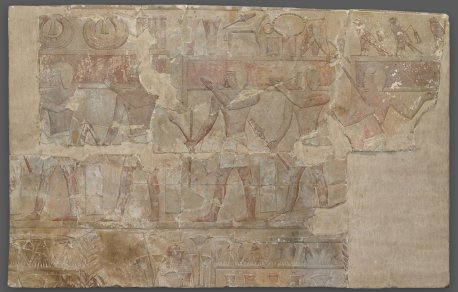Offering bearers from the Tomb of Montuemhat
Overview
Offering bearers from the Tomb of Montuemhat [ edit ]
This archaizing relief, a copy of a painting executed eight hundred years earlier, demonstrates an ancient Egyptian form of “Egyptomania”—an obsession with their own past, in both historical and aesthetic terms. Carved in raised relief and preserving traces of original paint, this limestone fragment from the tomb of Montuemhat depicts five offering bearers. The pairs of figures, each carrying different types of staves, shoulder rectangular chests, atop which appear necklaces, stone vessels, a chair, a kilt, and statues of divine falcons. According to Egyptian artistic convention, these items represent the contents of the chests. In a fragmentary register below the figures appear the tops of two festival booths, decorated with flowers and containing wine jars and foodstuffs. The offering bearers and booths immortalize the burial rites for the tomb owner, Montuemhat, themselves reminiscent of Egyptian New Year festivities. The fourth priest of Amun and de facto ruler of the important city of Thebes during the latter part of the seventh century B.C.E., Montuemhat commissioned one of the largest tomb complexes on the West Bank of Thebes (Theban Tomb 34).
The serene beauty of the carvings within Montuemhat’s eternal resting place belie the political turmoil of his time; Montuemhat began his career during the Twenty-fifth Dynasty, a line of Nubian kings, weathered an Assyrian invasion, and maintained his position when the Twenty-sixth Dynasty, from the Delta city of Sais, expelled the Assyrians. The Twenty-sixth Dynasty—and to a lesser extent the Twenty-fifth—are renowned for their archaistic tendencies, well in evidence in the Montuemhat offering bearers. The positions of the central two men, the rectangular chest, and the objects it contains were copied from a painting in the New Kingdom Theban tomb of Rekhmire (ca. 1370 B.C.E.). However, the male body proportions, the leg and arm musculature, and the style of their kilts are modeled on Egyptian art of the Old Kingdom (ca. 2500 B.C.E.). Rather than slavishly copying an earlier work of art, the Montuemhat relief embraces eclecticism, infusing the scene with a unique combination of earlier iconography and artistic styles.
Period
Late Period Egypt
Dimensions
H. 49.5 cm; L. 74.9 cm
Material
Painted Limestone
Museum
Yale Art Gallery
Accession Number
2003.28.1
Credit Line
Gift of Prof. William Kelly Simpson, B.A. 1947, M.A. 1948, Ph.D. 1954, in memory of his father Hon. Kenneth F. Simpson B.A. 1917, and grandfather Nathan Todd Porter, B.A. 1890
Peter der Manuelian, “Two Fragments of Relief and a New Model for the Tomb of Montuemhat at Thebes,” Journal of Egyptian Archaeology 71 (1985): 98-121.





















